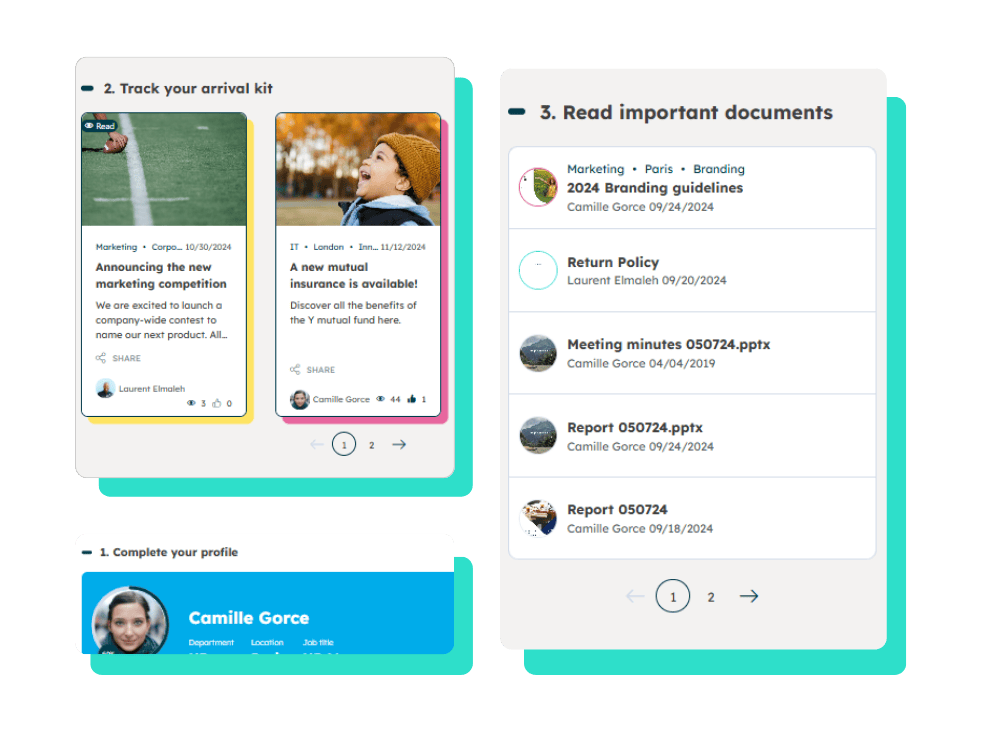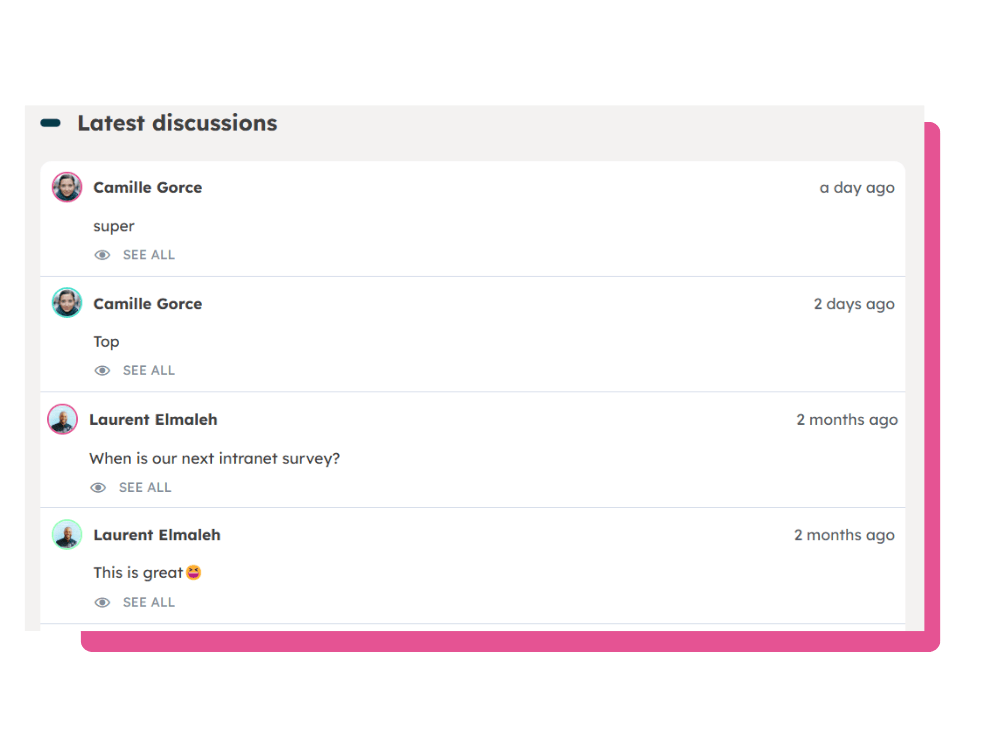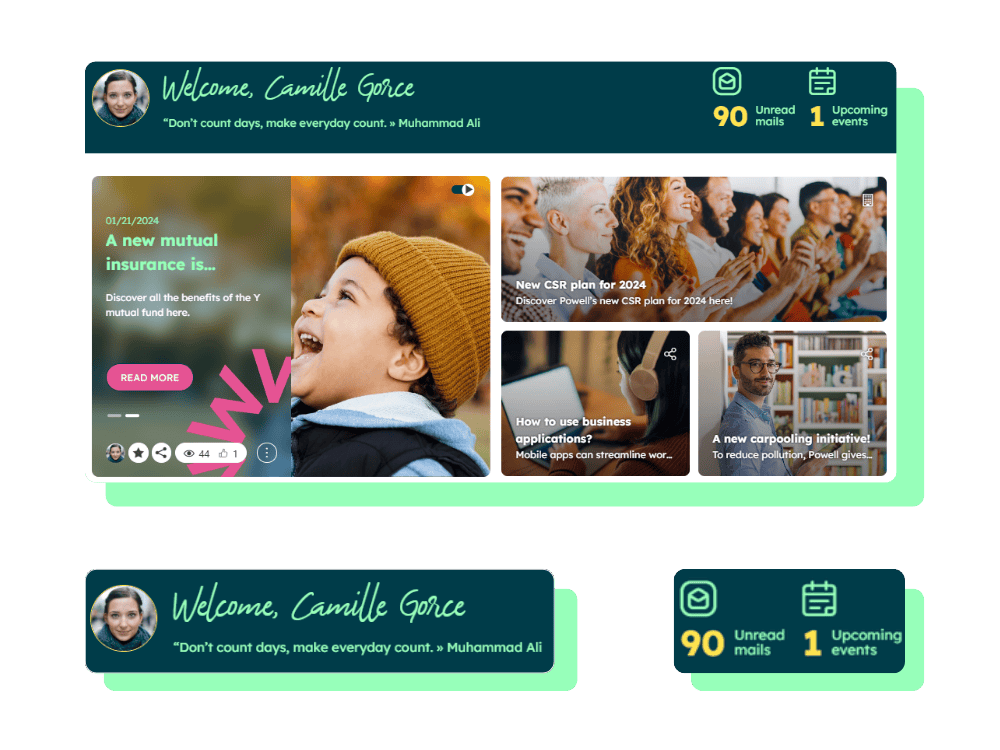
Use Powell to create inspiring employee experiences that drive positive impact and foster a sense of well-being in the workplace.
Powell is an intranet platform designed to prioritize and personalize the employee experience. Every employee feels valued, empowered, and ready to succeed in their role.

Thanks to these major groups for trusting us



Putting employees and their user experience at the heart of all digital workplace initiatives
An intranet shouldn’t be a mandatory, impersonal tool. At Powell, we transform intranets into valuable assets for professional and organizational success. We achieve this by fostering enjoyable collaboration with every click, scroll, and swipe, driving natural adoption and long-term engagement.
A diverse workforce with varied needs, aspirations, and preferences is a strength for any organization. This diversity should be reflected in personalized user experiences, creating a work environment as unique as each employee.

Seamless, personalized, and intuitive: the winning combination for optimal adoption and user engagement.



Each employee is unique, navigating different milestones within your organization. With Powell, you can deliver a tailored digital workplace that evolves with their needs. From welcoming new hires with relevant onboarding resources to providing seasoned employees with personalized tools that match their goals and interests, Powell ensures everyone effortlessly connects to the right content at the right time.
Fun at work can’t be forced—it flourishes when thoughtfully nurtured. To create this environment, the employee experience should be the cornerstone of your digital workplace, with engagement woven into every digital interaction.
With Powell, offer your teams an intuitive and enjoyable environment crafted to inspire spontaneous adoption and active use. Empower your employees to excel in their roles while experiencing the true joy of collaboration and connection.
Surprise employees with a user experience as seamless as their favorite digital tools. With Powell, create an environment that fosters collaboration, sparks initiative, and drives collective success.
Want to find out more? Don’t wait any longer.
One word, one move, Powell does the rest.
A digital workplace that generates lasting enthusiasm among your employees? It’s as easy as pie!
Encourage spontaneous adoption of your environments
With Guided Tour, automate interactive and engaging discovery experiences. Step-by-step sequences help employees quickly familiarize themselves with available tools and resources for optimal learning.
Customized content for every employee
Engage employees from day one and throughout their careers with customized resources tailored to their profile and needs. Lay the foundation for a positive, engaging culture from the start.
Create an attractive intranet environment that reflects your personality
Easily customize the layout of your home pages. Turn your employee portal into a hub for information and collaboration.
Transform your directory into a dynamic, collaborative tool
Transform your active directory from a simple IT database into a dynamic, interactive organizational chart where every employee can personalize and enhance their profile.
An intranet ecosystem designed to put the employee experience at the heart of interactions
Maximize the value of your intranet environment immediately
Get a quick return on your organization’s intranet investment with a ready-to-use, easy-to-deploy space and a wide selection of templates, sites, and pages.
Reflect your culture at the intranet core
Create an intranet that authentically reflects your corporate culture, design, and brand identity, regardless of department, entity, or geographic location.
Reinvent the user experience in your digital workplace
Provide a captivating and engaging environment that inspires your users. Encourage active participation in company life and foster sustained engagement.
Enjoy the simplicity of a customizable, scalable, and modular digital workplace
It’s possible to be firmly rooted in today’s practices, while staying one step ahead of tomorrow’s employee habits! Powell will keep you up to date with the new and upcoming uses of your teams.
Say goodbye to the basic intranet and embrace Powell’s collaborative and interactive environment!
Powell, much more than a functional tool, a growth lever that generates commitment.
Flex Desk
Maximize the efficiency of your work environment with a digital representation of your physical spaces (room availability, office space, etc.) to promote best practices.
Gamification
Reward completion of courses or actions (badges, kudos, points, etc.) to encourage best use.
Community and exchange space
Facilitate easy exchange of ideas and collaboration among employees through dedicated spaces for specific professions, projects, and communities of interest.
Customization
Offer each employee a tailor-made experience by personalizing the display of their home portal: home page, information, widgets, and favorite applications.
Customized design, look & feel
Choose from a wide range of ready-to-use templates and pages, offering easy customization without the need for technical expertise.
Interaction
An employee experience built on interactive features—including likes, comments, polls, and forums—to foster renewed engagement.
Multi-device
Ensure seamless intranet access from any user’s preferred environment: desktops, tablets, Microsoft Teams, or the Powell Apps mobile application.
Improved and enhanced directory
Transform your active directory into a dynamic and engaging space where employees can easily connect and interact.
Disclaimers
Notify users of new environments or important changes—such as a new user charter or policy requiring approval—with targeted notifications.
User path templates
Easily implement customized onboarding programs to support and guide employees through essential steps.
User Analytics
Measure and manage the adoption and usage of your digital workplace with Powell’s analytics.